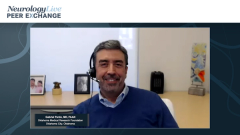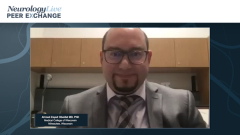
Patient Case #1: 37-Year-Old Female With RRMS
Expert neurologists review treatment options for a young female with relapsing remitting multiple sclerosis (RRMS).
Episodes in this series

Ahmed Zayed Obeidat MD, PhD: The first case we’re going to talk about is a 37-year-old female with 2 young children. We’re going to talk about some factors about what you would select as a treatment. The patient presented to the neurology clinic for first time with fatigue, weakness, tremors in the right hand, so that’s 1 side. And then medical history was significant for previous numbness and tingling in the lower extremity which was both and the result spontaneously about 2 years ago—not an uncommon scenario where people had maybe a pinched disc or something and they didn’t get medical attention because it went away on a physical exam. She had mild right upper extremity weakness and then increased tone in her right hand, already with increased tone, and some mild intention tremor. That’s important to keep in mind. And then gait was stable but had some hyperreflexia on examination. So those are some of the symptoms she presented with.
You did an MRI, and there were some lesions consistent with demyelination, and then spinal fluid showed unique oligoclonal bands. So, the diagnosis was consistent with what appears to be a relapsing remitting MS [multiple sclerosis].I’ll start with you, Dr Dukkipati. What’s your impression of this case and the initial treatment recommendation? How would you treat this patient?
Ravi Dukkipati, MD: Based on the vignette given, this is a relatively young woman, still of childbearing age with 2 young children, who I’m presuming is fairly active, and by all means has relapsing remitting multiple sclerosis based on the clinical presentation. And the brain MRI demonstrates multiple areas of demyelination, which is concerning, and I would characterize this woman as having a moderate disease burden both clinically and radiographically.
This is the type of patient whom I would not hesitate in terms of being aggressive from the beginning because the concern is that time is brain matter. And so, I generally don’t start new patients on platform therapies any longer, so the real decision-making in my mind would be between one of the oral therapies vs monoclonal antibodies with a patient like this or natalizumab.
Ahmed Zayed Obeidat MD, PhD: Dr Pardo?
Gabriel Pardo, MD, FAAN: Yes, I completely agree. I think there are some concerning signs already in this patient. I assume she’s right-hand dominant just by statistics and that’s where she has most of her symptoms. She already has dexterity problems spasticity problems weakness problems, and it’s not harboring good things for the future. The burden of disease seems to be high, and the diagnosis is straightforward. So, I am concerned about this patient. I think that there is no time to waste with platform therapies; there is no doubt about that.
Other elements we were discussing to individualize the decision-making along with the patient will be, as Dr Dukkipati mentioned, as she is still of childbearing age, is she planning on having more children? That will be a very important aspect in the counseling of this patient regarding the selection of the different agents that we have. And each one of them will have different characteristics in that regard. Some of them will allow her to be treated with 4 courses and then be free of treatment if she is able to delay pregnancy for 2 years, for example, maybe 2½ years 1½ years, or 18 months. Or she might imply the decision of having to stop treatment to pursue pregnancy with the risk of a potential rebound if she does not become pregnant promptly. So, a lot of elements again become important in individual patients, and for this patient, we’ll have to get that in the conversation to be able to counsel her in addition. But from the get-go, I am concerned about the patient, and she should definitely be on high-efficacy therapies. There’s no time to beat around the bush.
Ahmed Zayed Obeidat MD, PhD: Yes, and I agree because as you mentioned, there are already signs of incomplete recovery. There are signs of maybe brain stem involvement here, right? There’s a tremor, there is maybe cerebellar involvement. And that’s concerning when we think about her young age and that it was previously untreated for probably over 2 years because the first episode was over 2 years ago with what appears to be transgressed myelitis, which is again another spinal cord involvement which carries a poor prognosis sometimes. So I would do the same. I would start with a highly effective therapy for her. And then maybe, again, considering other factors; when she wants, if she wants more children, when the plan is. And we’ll work around many of these factors.
So I’m going to tell you a little bit of what happened. Maybe she was not started on highly effective therapy. So despite receiving disease-modifying therapy [DMT], she had 2 more relapses in the past year. She reported increased fatigue, difficulty with memory and concentration. And her exam showed right-sided weakness and wrist reflexes are still there, but more weakness. Another MRI of the brain shows multiple new and enhancing lesions while on a disease-modifying therapy, suggestive of ongoing disease activity. Her fatigue and memory issues are interfering with job performance. Now her symptoms are starting to affect her day-to-day and then maybe threatening her job or maybe could result in her losing her job. So this is now even more concerning. So now the patient comes back to you and asks, “How would you monitor? How would you treat me? What else can I do?" Dr Dukkipati, I’ll start with you for this one now, and then we’ll see what Dr Pardo has to say.
Ravi Dukkipati, MD: Well, this is clearly the worst-case scenario, what we had talked about earlier. This woman unfortunately is progressing. Clinically she’s had several relapses. She’s exhibiting signs of progression and her MRI studies clearly demonstrate a very active disease, involving both the brain and the spinal cord. Now, we don’t necessarily know what her initial disease-modifying therapy was, but clearly, she’s failing with that initial therapy. And this patient would need close monitoring both clinically and radiographically and imminent or immediate change or escalation of therapy to a different class.
Ahmed Zayed Obeidat MD, PhD: Dr Pardo, do you agree, and do you have any other additional thoughts?
Gabriel Pardo, MD, FAAN: Absolutely. I agree completely. And just this case highlights the fact that in addition to our selection of the disease-modifying therapy, we need to be always in tune with the patient’s needs and the fact that MS is multifaceted, it has a lot of manifestations, and that it does require comprehensive management of the disease. We need to go beyond the selection of the DMT. We need to explore all these other possibilities.
The threat of potentially losing her job has tremendous social, familial, and personal implications. And it brings then the conversation of the complementary things that we do to the DMTs, which are symptom management and trying to improve function, something that we also need to monitor closely. It is not just the markers that we use for failing a treatment as clearly evident in this case with relapses, and new MRI additions, but all these other ancillary ways of assessing how the patient is functioning and what else should we do, and can we do to improve that function, and to improve the ability of the patient to continue to live their life the best they can?
Ahmed Zayed Obeidat MD, PhD: Yes, and what strikes me in this case is also that she had 2 relapses in the past year, so she was left to relapse again after 1 relapse. So we didn’t have to even wait for that, right? You see 1 relapse, and for me, it’s sufficient to just switch to a different mechanism of action, and in this case, perhaps going higher; something with known higher efficacy.
Transcript edited for clarity
Newsletter
Keep your finger on the pulse of neurology—subscribe to NeurologyLive for expert interviews, new data, and breakthrough treatment updates.





























